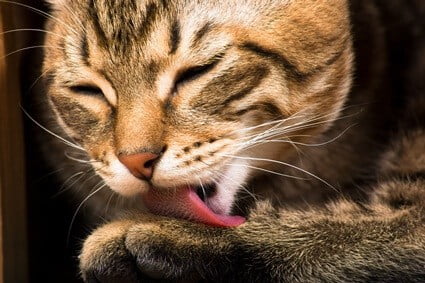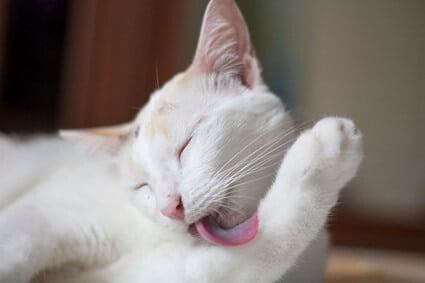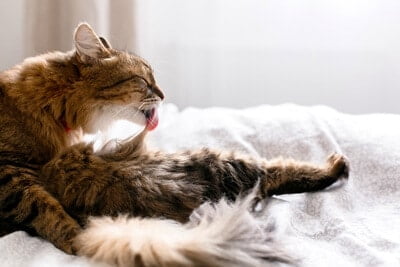Cats normally have two shedding seasons per year. The first happens after winter to shed the winter coat in readiness for the warmer weather. The second happens before fall to prepare for the growth of their cold-weather coat. However, this isn’t the same as abnormal shedding and fur loss.
Cats lose or pull their fur out in chunks due to allergies, skin parasites, environmental changes, and their breed. Illnesses that cause fur pulling are hyperthyroidism, alopecia, cancer, heart disease, or diabetes. Skin parasites that cause itchy skin include fleas, lice, ticks, and skin mites.
If your elderly cat pulls fur out, it’s most likely due to arthritis pain, hyperthyroidism, or nutritional deficiencies. To assist your cat, narrow down the exact reason. Some of the symptoms may coincide, or they may be independent. Regardless of the case, note any abnormal behavior before consulting a vet.
Why Does My Cat’s Fur Clump Up?
When a cat’s shedding, it’s natural for the fur to clump up. Cats shed their undercoat, so the fur gets caught in the top coat.
It stays there as more thin strands add to the bulk and eventually form a clump. The clump loosens over time and through activity before being deposited as a large furball.
Of course, cats may also lose clumps of fur outside of the shedding season as they lose hair all the time. If the cat is especially oily or dirty, the individual strands will get caught up in the top coat.
As with shedding, the fur will gather until it’s shaken loose as a clump. You can limit this clumping by brushing the fur and removing the excess.
However, if your cat is always losing hair in clumps, this is a concern. Cats are ritual groomers, so it’s unnatural for them to ignore clumps in their fur. They should have a strong desire to clean themselves up.
If your cat seems to avoid grooming, this could be a sign of stress or illness.
Why is My Cat Losing Clumps of Fur?
Cats shouldn’t be shedding large clumps of fur regularly. Outside of shedding season, this means your cat may have:
- Allergies
- Skin parasites
- Intestinal parasites
- Illness or disease
- Dermatitis
- Stress
- Nutritional deficits
- Engaged in rough activity
Of course, these causes are not mutually exclusive and could overlap with one another.
Dermatitis
Dermatitis refers to any inflammation of the skin. Your cat can develop dermatitis due to:
- Skin or intestinal parasites
- Stress
- Nutrition deficits
- Allergens
- Injury
Despite the various causes, dermatitis symptoms are often the same. Symptoms include:
- Itchiness
- Scaling of the skin
- Redness
- Inflammation
- Scabbing and infection (if left untreated)
Nutrition Deficiencies
Nutritional balance is necessary for your cat to grow and maintain healthy fur.
In particular, fatty acids and omega-3s are beneficial for maintaining your cat’s skin and fur health. With enough, it can even recover from deficiencies better than before.
The cat’s fur begins to fall out when this doesn’t happen. If the skin is compromised, this can lead to hair clumping.
The most common nutritional deficiencies include:
- Low fat content
- Low quality protein
- Poor digestibility
- High levels of nutrients (which inhibit the way other nutrients are absorbed)
- Deficiency of essential fatty acids (EFA)
A lack of EFA can result in:
- Scaly and dry skin
- Matted fur
- Less elastic skin
- Higher susceptibility to infections
A copper deficiency can cause:
- Dull, dry fur coats
- Patchy hair loss
- Loss of hair pigment
Why Does My Cat Keep Pulling Hair Out?
It’s worrying when you find your cat frantically pulling out its fur because this isn’t a natural behavior.
While cats groom themselves and remove dead fur, it’s not excessive. A cat that’s regularly removing large clumps of fur is experiencing a health issue.
You may even find your cat biting and scratching at itself. If you find your cat pulling out fur and losing weight, you’ll need a vet’s intervention.
It could mean that your cat has a:
Medical Illness
Several medical conditions result in your cat pulling out fur and losing weight. These include:
Hyperthyroidism
Hyperthyroidism is a disease that’s characterized by a hyperactive thyroid gland. This occurs due to the excessive production of thyroid hormones, so the thyroid gland is stimulated far more than necessary.
Hyperthyroidism can increase your cat’s metabolism, causing it to lose weight faster than it can gain weight by eating. Once malnourished, it’ll also start losing fur.
Certain cat species are genetically predisposed to developing hyperthyroidism.

Cancer And Heart Disease
Both cancer and heart disease can result in a cat losing excessive amounts of hair. It’ll also begin losing weight due to diseases or a lack of appetite.
Diabetes
Diabetes develops from a lack of insulin production. Insulin is a hormone that’s primarily responsible for regulating the sugar levels in the blood.
Due to a lack of insulin, your cat may begin losing weight, and its fur quality may decrease. This can contribute to your cat pulling out its fur.
Alopecia (Hair Loss)
Alopecia is a common symptom of illness in cats, making it difficult to narrow down the cause without tests.
Allergies
Persian cats often host a dermatophyte infection or fungi. How badly a cat will be affected (if at all) depends on its health, environment, and genetics.
The most common symptom of an allergen is itchy skin. Known as pruritus, this further exacerbates hair loss. Your cat may lose its appetite due to stress and begin shedding weight.
Allergic reactions can cause miliary dermatitis in cats. This is a skin condition characterized by flaky, itchy rashes. It can be aggravated when your cat scratches, licks, or rubs the spot for relief.
If your cat gets obsessive, it can result in:
- Large bare patches where hair won’t grow
- Scabs
- Skin infections
Miliary dermatitis can cause thinning of the fur, causing your cat to shed fur at a rapid pace.
The most commonly affected areas are the following:
- Lower spine
- Base of the tail
- Face
- Ears
- Neck
- Flank
- Belly
How did your cat get these allergies? The causes include:
Environmental Allergens
Depending on where your cat spends the majority of its time, it may be exposed to:
- Pollen
- Grass
- Fungi
- Mold
- Dust
- Cigarette smoke
- Perfume or cologne, other fragrances
- Cleaning products
According to Mycoses, stray cats pick up different kinds of fungi. This lives on and in their fur, thriving on warmth, dampness, and dead skin cells.
Insect Allergens
Cats are good hunters and often target insects to eat and play with.
Unfortunately, if your cat develops an allergy from these insects, it can affect the cat’s fur:
- Fleas
- Spiders
- Ticks
- Ants
- Bees
- Wasps
Food Allergies
These food types may trigger allergies in certain cats:
- Beef
- Fish
- Chicken
- Dairy
Skin Parasites
Skin parasites are commonly associated with hair loss. According to Veterinary Parasitology, parasites can even live in the fur once it’s been shed. This can spread them around your home, affecting your family and other pets.
Alongside fur clumping, your cat may experience a loss of appetite. This is caused by the stress its body experiences when hosting these parasites.
If you suspect that your cat is losing fur due to skin parasites, these are the likely culprits:
- Fleas
- Lice
- Skin mites
- Ticks
Fleas
Flea bites may encourage your cat to itch incessantly. This can lead to excessive fur loss, either by scratching or manually pulling out hair.
Because your cat’s claws are sharp, constant itching in the same area will lead to open wounds, scabs, and infections. The fur loss and scabs will be localized where the fleas live on your cat’s body.
The most common areas of the body to find fleas include the following:
- Lower back
- Thighs
- Stomach
- Head
- Around the neck
- Tip of the tail
Your cat isn’t safe just because it’s wintertime. Fleas can still survive in the cold, especially if they have a warm host to live on. Fleas are the primary cause of allergic reactions and skin problems in domestic cats.
Intestinal parasites, namely tapeworms, can also accompany flea infestations. This happens when your cat ingests fleas during grooming.
Lice
Lice (Felicola subrostratus) are 1-2 mm, are white/tan in color, and can be observed moving on your cat. They may cause itchy skin, scratching, and hair loss in clumps. You’re most likely to find lice around the head and neck regions.
They’re not commonly found among house cats but are a problem for cats that venture outdoors. Many flea products can also be used to get rid of lice. They’re species-specific pests that won’t be passed on to humans.
Skin Mites
Skin mites will lead to cats pulling out their fur and scabs.
Cheyletiella mites cause Cheyletiellosis (walking dandruff). It got this name as you can see them move on the upper layer of the skin.
Ticks
Of the 850+ tick species, only a small number use cats as their primary host.
Your cat is more likely to be exposed and vulnerable to ticks if they’re outdoor cats. That’s because most tick species that use cats as a primary host can be found on the following:
- Tips of grass
- Leaves of shrubs
Like the other skin parasites, a tick bite can lead to irritation, broken skin, and infection. If your cat cannot ease the itchiness, it could pull fur out in chunks.
Here are the ticks most likely to affect cats in North America:
- American dog tick
- Lone star tick
- Deer/blacklegged tick
- Brown dog tick
- Longhorned tick
Ticks are dangerous parasites, and you should be especially cautious of the longhorned tick.
Sudden Changes To A Cat’s Environment
Cats much prefer a day-to-day routine and predictability in their lives. So, any sudden changes to their environment can be distressing. They may trigger stress responses in your cat, leading to fur-pulling and weight loss.
Changes to your cat’s environment go hand in hand with medical causes, allergies, and skin parasites. However, there doesn’t need to be a medical explanation for your cat to be stressed.
Stress triggers include:
- Conflict amongst other cats (domestic and feral) or people
- Changes to (or replacements of) well-liked bedding, housing, or toys
- Fluctuations in temperature (too hot or too cold)
- Loud noises
- Bright lights
- Unfamiliar people or other animals
- Limiting space availability
- Changing location (moving to a new place, living with new owners, etc.)
- Extreme boredom
- Loneliness
Stress can induce psychogenic alopecia, which is hair loss caused by extreme stress. This is the likely explanation if your cat is tearing its fur out.
Of course, not all environmental changes which cause fur loss are inherently negative. Changes that seem innocent on the surface may lead to hair-pulling.
These include the following:
- Introducing new pets, babies, or children
- Adding new toys, household items, scents
- Having guests over in the house on a regular basis
Ensure that nervous or anxious cats have a space to retreat to. Likewise, new people, toys, or environments should be introduced gradually.

Certain Cat Breeds
Some breeds of cats are genetically predisposed to fur loss and, thus, pulling their hair out. They may have inherited weaker hair follicles, making it easier to remove the fur themselves.
These cat breeds are usually pure-bred, oriental breeds, such as:
- Burmese
- Siamese
- Bengal
Pure-bred breeds have 2 copies of a non-dominant gene, resulting in fur loss susceptibility. This is commonly found in the Burmese and Siamese breeds.
It’s also autosomal or hereditary. As such, it’s passed throughout the generations and persists even if your cat’s parents or grandparents didn’t exhibit it.
Other cat breeds may have one or no copies of the non-dominant gene that controls a vulnerability to hair loss. So, we don’t see genetic causes of fur loss in other cat breeds.
Why is My Elderly Cat Pulling Fur Out?
Older cats pull out their hair for the same reasons. However, other causes affect senior cats more than kittens or younger cats. These include:
Arthritis
As your cat ages, its joints will experience wear and tear. This leaves them vulnerable to arthritis, which is characterized by inflammation of the joints.
Of course, grooming is soothing to cats. Older cats may begin licking and pulling fur out from areas where they experience arthritis pain.
If your elderly cat is pulling fur out around its legs and thighs, arthritis may be the cause.
Hyperthyroidism
Senior cats are more likely to develop hyperthyroidism than younger cats. Cats 13 years or older are most susceptible.
Nutrient Deficiencies
Old cats are more sensitive to diet changes or deficiencies. The older they get, the more scrutiny you must place on their diet.
Poor diet, especially in elderly cats, can result in dull fur and weak hair follicles, making fur pulling easier.
Is It Dangerous For Cats To Lose Hair In Clumps?
If you notice any signs of illness (or stress) in your cat, consult your veterinarian.
Hair loss can be a serious condition in cats that could cause the following problems:
- Inability to regulate their body temperature
- More exposed and vulnerable to the sun
- Skin damage while pulling out fur
- Wounds that lead to infection
- Hair follicle damage that prevents the fur from regrowing
You can implement a vet-recommended solution by identifying the fur-pulling problem sufficiently early. This will mean that your cat’s fur and skin will recover, growing back thick, strong, and healthy.


Mr. Parker, My name is Teresa & I have a 15 yr old cat named Onyx. I’ve had him since he was little. His mother got hit by a car, so I’ve had him since then. On his back, he is pulling out his fur. He is a solid black 19 pounds & 15 yrs old. I have read several articles & you have a lot of information but I’m still searching for cause or what to do. He has always been indoors. I’ve had Chihuahuas & other cats & he’s been ok. So no changes in his bedding, laundry or nothing I can think of. I treat him & my dog for fleas. I’m on disability, so money is tight. My problem is I took to vet 1 time in 15 yrs to be treated for fleas. He doesn’t have hairballs & knock on wood, never been sick. When I took him to vet, he cried all the way there, & peed & poo’d in his carrier on the way there. They gave me rx for trazodone. I used to take this. A half of pill 30 to 45 mins before I tried putting him in crate. Did nothing for him. So as old as he is & how scared he gets, I hate to put him through that again. Any suggestions? Thanks Teresa
Teresa, I am no vet, only a cat lover myself. Seems Trazodone is a strong antidepressant, I would not give it to my cat. How about trying natural treatment like let him smell catnip? Please be careful with the dosage, read the writing on the label how much your kitty should take! A pinch should be enough. And smelling it is better than eating it. And beware, it may cause seizures for an older kitten. Probably we just need to put up with cat anxiety when we took them to the vet.
Good luck, Dianne
Hi Teresa,
I’m also not a Vet, but a cat lover and proud owner of two beautiful older lady cats. Tikka sadly passed at the age of 20 but our other cat, her daughter Ruby, is still going strong aged 20 and a quarter. She also hates being ‘contained’ in her cat carrier. Over the years, I found it better to sit on the back seat of the car (while my husband drives) with Ruby either sitting next to me or on my knee (with several towels to hand just in case!). I think she feels like we’re just sitting on the sofa! She’s never had any toilet accidents and weirdly doesn’t cry. You could get a collar and lead/leash for extra security if needed. It sounds like Onyx could have arthritis (or another condition) though – Ruby also licks excessively and pulls out her fur when her legs are sore. There are different treatments for arthritis which do work so it might be worth having a chat with your Vet.
Hope this helps,
Suzanne